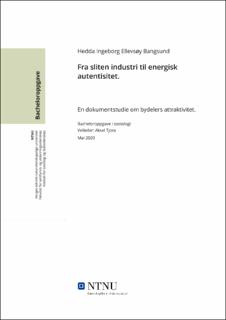Fra sliten industri til energisk autentisitet.
Abstract
Denne bacheloren er et rent dokumentstudie, hvor formålet med studien har vært å finne ut hvorfor noen bydeler ansees som mer attraktiv enn andre. Studien har fulgt SDI-modellens etapper, hvor koding har vært en sentral del av det metodiske arbeidet. Gjennom en sosialkonstruktivistisk tilnærming, har magasiners fremstilling av bydeler blitt drøftet for å finne et svar på problemstillingen. Berger og Luckmanns legitimeringsprosess har vært det sentrale teoretiske bidraget til studien, sammen med gentrifiseringsbegrepet. Drøfting av begrepet autentisitet utgjør store deler av diskusjonen, og er ansett som en av grunnene til at tidligere industristrøk i dag blir sett på som attraktive. This bachelor thesis is a document study, where the purpose of the study has been to find out why some districts are considered more attractive than others. The study has followed the SDI-model, with coding as a central part of the methodological work. Through a social-constructivist approach, magazines' portrayal of neighborhoods has been discussed to find an answer to the research question. Berger and Luckmann's process of legitimation has been the central theoretical contribution to the study, along with the concept of gentrification. The concept of authenticity constitutes a major part of the discussion, and is considered one of the reasons why earlier industrial districts are seen as attractive today.
